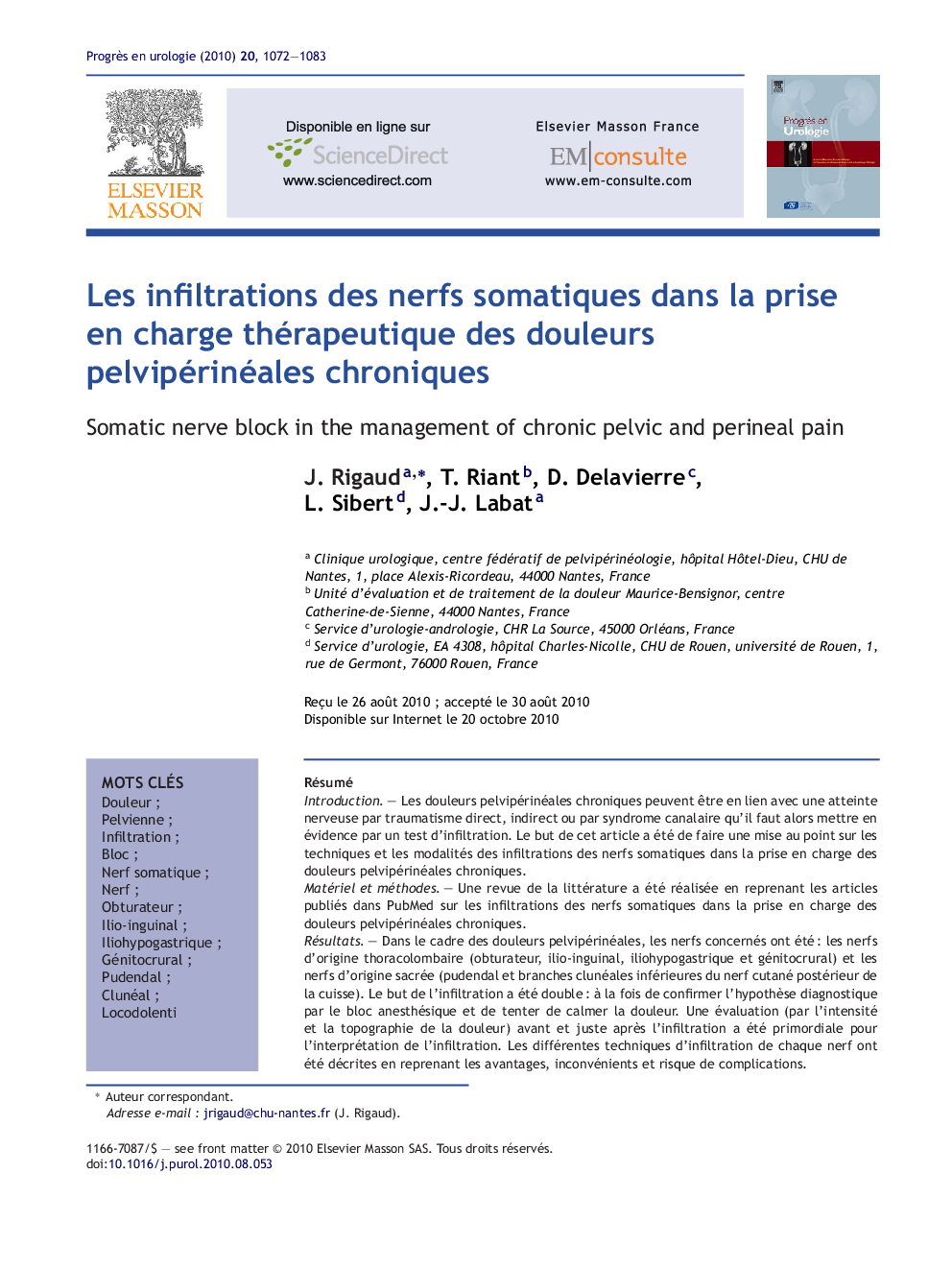| Article ID | Journal | Published Year | Pages | File Type |
|---|---|---|---|---|
| 3823773 | Progrès en Urologie | 2010 | 12 Pages |
RésuméIntroductionLes douleurs pelvipérinéales chroniques peuvent être en lien avec une atteinte nerveuse par traumatisme direct, indirect ou par syndrome canalaire qu’il faut alors mettre en évidence par un test d’infiltration. Le but de cet article a été de faire une mise au point sur les techniques et les modalités des infiltrations des nerfs somatiques dans la prise en charge des douleurs pelvipérinéales chroniques.Matériel et méthodesUne revue de la littérature a été réalisée en reprenant les articles publiés dans PubMed sur les infiltrations des nerfs somatiques dans la prise en charge des douleurs pelvipérinéales chroniques.RésultatsDans le cadre des douleurs pelvipérinéales, les nerfs concernés ont été : les nerfs d’origine thoracolombaire (obturateur, ilio-inguinal, iliohypogastrique et génitocrural) et les nerfs d’origine sacrée (pudendal et branches clunéales inférieures du nerf cutané postérieur de la cuisse). Le but de l’infiltration a été double : à la fois de confirmer l’hypothèse diagnostique par le bloc anesthésique et de tenter de calmer la douleur. Une évaluation (par l’intensité et la topographie de la douleur) avant et juste après l’infiltration a été primordiale pour l’interprétation de l’infiltration. Les différentes techniques d’infiltration de chaque nerf ont été décrites en reprenant les avantages, inconvénients et risque de complications.ConclusionLes infiltrations nerveuses font partie intégrantes de la prise en charge des douleurs pelvipérinéales chroniques d’origine nerveuse somatique. Elles sont majoritairement réalisées sous contrôle tomodensitométrique afin d’être le plus sélectif possible. Une fois le diagnostic et le niveau d’atteinte nerveuse connu, des gestes thérapeutiques plus spécifiques peuvent alors être proposés.
SummaryIntroductionChronic pelvic and perineal pain can be related to a nerve lesion caused by direct or indirect trauma or by an entrapment syndrome, which must then be demonstrated by a test block. The purpose of this article is to review the techniques and modalities of somatic nerve block in the management of chronic pelvic and perineal pain.Material and methodsA review of the literature was performed by searching PubMed for articles on somatic nerve infiltrations in the management of chronic pelvic and perineal pain.ResultsNerves involved in pelvic and perineal pain are: thoracolumbar nerves (obturator, ilioinguinal, iliohypogastric and genitofemoral) and sacral nerves (pudendal and inferior cluneal branches of the posterior cutaneous nerve of the thigh). Infiltration has a dual objective: to confirm the diagnostic hypothesis by anaesthetic block and to try to relieve pain. Evaluation of the severity and site of the pain before and immediately after the test block is essential for interpretation of the block. The various infiltration techniques for each nerve are described together with their respective advantages, disadvantages and risk of complications.ConclusionSomatic nerve blocks are an integral part of the management of chronic pelvic and perineal pain and are predominantly performed under CT guidance in order to be as selective as possible. Once the diagnosis and the level of the nerve lesion have been defined, more specific therapeutic procedures can then be proposed.
